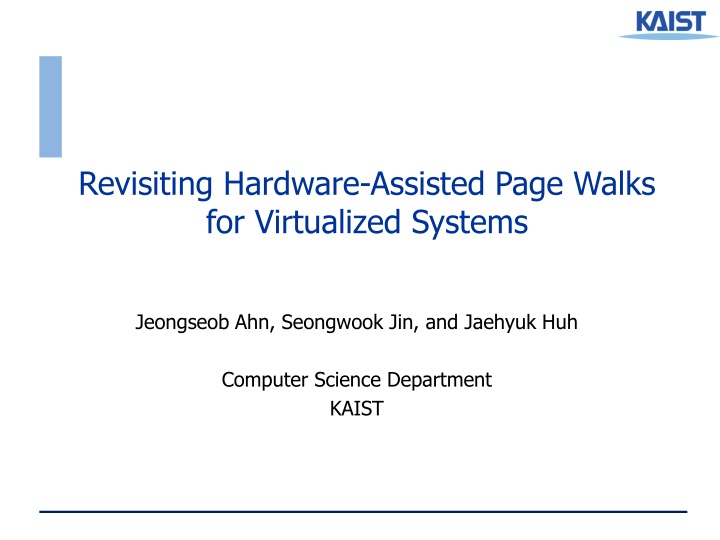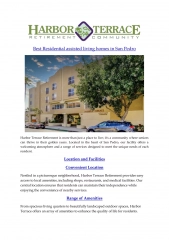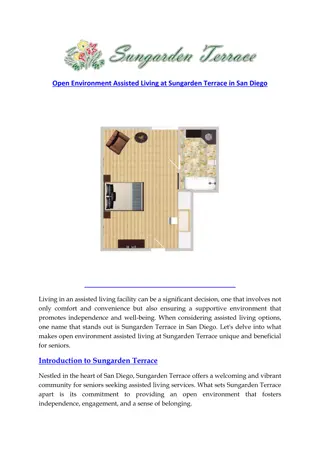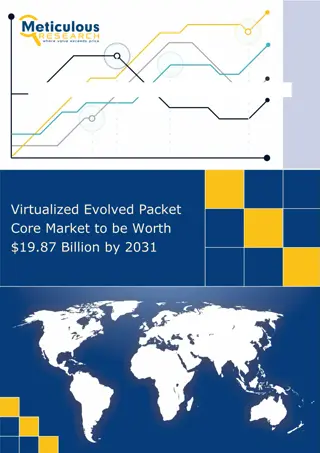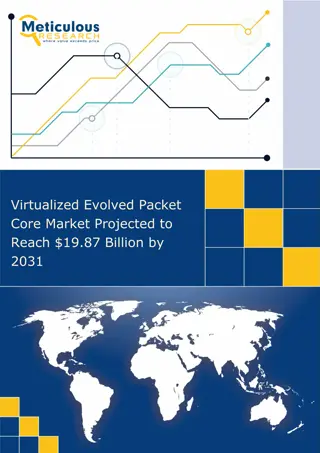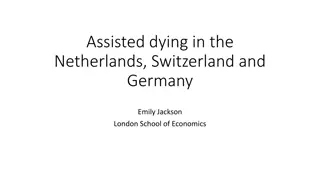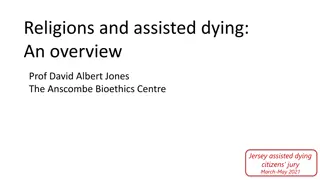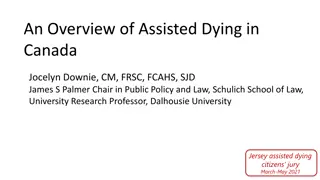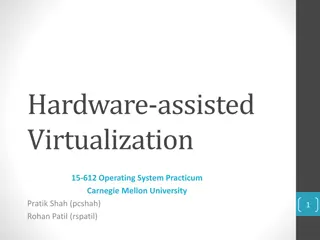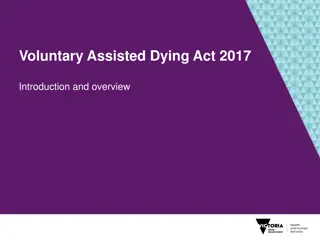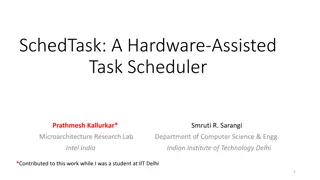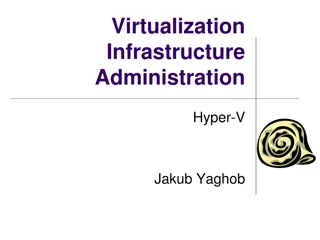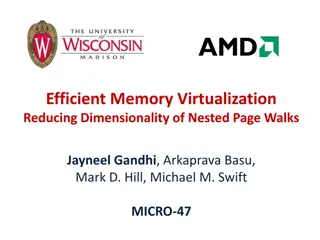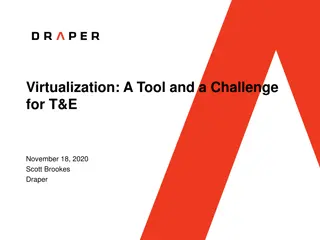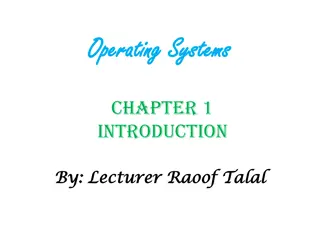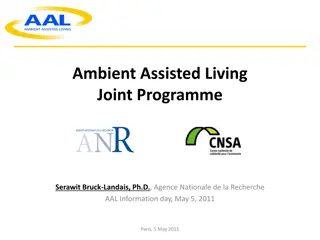Hardware-Assisted Page Walks for Virtualized Systems
Virtualization in cloud computing and server consolidation relies on hardware-assisted page walks for address translation in virtualized systems. This involves two-level address translations to ensure isolated address spaces for each virtual machine, utilizing multi-level page tables to manage memory efficiently. The current hardware page walker assumes a consistent organization for guest and nested page tables in virtualization. Hardware-assisted page walks facilitate efficient address translation for virtualized systems, enhancing performance and resource management.
Download Presentation

Please find below an Image/Link to download the presentation.
The content on the website is provided AS IS for your information and personal use only. It may not be sold, licensed, or shared on other websites without obtaining consent from the author.If you encounter any issues during the download, it is possible that the publisher has removed the file from their server.
You are allowed to download the files provided on this website for personal or commercial use, subject to the condition that they are used lawfully. All files are the property of their respective owners.
The content on the website is provided AS IS for your information and personal use only. It may not be sold, licensed, or shared on other websites without obtaining consent from the author.
E N D
Presentation Transcript
Revisiting Hardware-Assisted Page Walks for Virtualized Systems Jeongseob Ahn, Seongwook Jin, and Jaehyuk Huh Computer Science Department KAIST
System Virtualization Widely used for cloud computing as well as server consolidation Hypervisor serves resource managements E.g.,) CPU, Memory, I/O, and etc VM1 VM2 App App OS OS Virtual Virtual Hypervisor Physical Physical System 2
Address Translation for VMs Virtualization requires two-level address translations To provide isolated address space for each VM Guest Virtual Address System Physical Address Guest Physical Address Guest Page Table (per process) Nested Page Table (per VM) Guest page tables are used to translate gVA to gPA Guest virtual address gPPN Offset Offset gVPN Guest physical address Page table 3
Does it make sense ? Memory required to hold page tables can be large 48-bit address space with 4KB page = 248/212= 236Pages 47 offset VPN 11 0 212 236 Flat page table: 512GB (236 x 23= 239) Page tables are required for each process Multi-level page table VA: offset L3 L2 L1 L4 Base address (CR3) 4
Address Translation for VMs Virtualization requires two-level address translations To provide isolated address space for each VM Guest Virtual Address System Physical Address Guest Physical Address Guest Page Table (per process) Nested Page Table (per VM) Current hardware page walker assumes the same organization for guest and nested page tables AMD Nested paging Intel Extended Page Table 5
Hardware-Assisted Page Walks Two-dimensional page walks for virtualized systems gCR3 gVA gL4 5 gL3 10 gL2 15 gL1 20 Guest page table (gLn) x86_64 gPA (gL4) Nested page table (nLn) nL4 1 nL4 6 nL4 11 nL4 21 nL4 16 nCR3 nL3 2 nL3 7 nL3 12 nL3 17 nL3 22 nL2 8 nL2 13 nL2 18 nL2 23 nL2 3 gVA: guest virtual address nL1 4 nL1 9 nL1 14 nL1 19 nL1 24 gPA: guest physical address sPA: system physical address sPA sPA 6
Hardware-Assisted Page Walks Two-dimensional page walks for virtualized systems x86_64Guest (m-levels) and nested (n-levels) page tables # of page walks: mn + m + n gCR3 gVA gL4 5 gL3 10 gL2 15 gL1 20 Guest page table (gLn) x86_64: 4*4 + 4 + 4 = 24 gPA (L4) nL4 1 nL4 6 nL4 11 nL4 21 nL4 16 Nested page table (nLn) nCR3 nL3 2 nL3 7 nL3 12 nL3 17 nL3 22 gVA: guest virtual address nL2 8 nL2 13 nL2 18 nL2 23 nL2 3 gPA: guest physical address Can we simplify the nested page tables ? sPA: system physical address nL1 4 nL1 9 nL1 14 nL1 19 nL1 24 sPA sPA 7
Revisiting Nested Page Table Exploit the characteristics of VM memory management # of virtual machines < # of processes There are 106 processes in a Linux system after booting Differences address space between VMs and processes < 11 0 31 47 11 0 47 gPPN offset offset gVPN Guest physical address space e.g.) 32bit (4GB VM) Guest virtual address space 48bit Virtual machines use much of the guest physical memory Processes use a tiny fraction of virtual memory space 8
Revisiting Nested Page Table Exploit the characteristics of VM memory management # of virtual machines < # of processes There are 106 processes in a Linux system after booting Differences address space between VMs and processes < Multi-level nested page tables are not necessary!! 11 0 31 47 11 0 47 gPPN offset offset gVPN Guest physical address space e.g.) 32bit (4GB VM) Guest virtual address space 48bit Virtual machines use much of the guest physical memory Processes use a tiny fraction of virtual memory space 9
Flat Nested Page Table Guest physical address Physical memory Offset gPPN Base address (nCR3) Flat nested page table Reduces the number of memory references for nested page walks 10
Flat Nested Page Table Memory consumption Process Virtual Machine (4GB) 248/ 4KB = 68,719,476,736 232/ 4KB = 1,048,576 # of pages # of pages x 8B = 512GB #of pages x 8B = 8MB Flat Page table size 11
Page Walks with Flat Nested Page Table gCR3 gCR3 gVA gVA gL4 5 2 gL4 gL4 gL4 10 4 gL4 15 6 gL4 gL4 20 8 gL4 Guest page table Guest page table gPA gPA nL4 nL4 1 1 nL4 6 3 nL4 nL4 11 5 nL4 nL4 nL4 21 9 nL4 16 7 nL4 Nested page table Nested page table nCR3 nCR3 sPA nL3 2 nL3 7 nL4 12 nL4 17 nL4 22 nL2 8 nL4 13 nL4 18 nL4 23 nL2 3 Reducing 15 memory references from current 24 references nL1 4 nL1 9 nL4 14 nL4 19 nL4 24 sPA sPA 12
Does it make sense ? Flat nested table cannot reduce # of page walks for guest page tables It still requires 9 memory references We would like to fetch a page table entry by a single memory reference Guest Virtual Address System Physical Address ? Traditional inverted page table can do it !! 13
Traditional Inverted Page Table Provides direct translation from guest to physical pages Virtual address Physical frames Offset VPN Inverted Page Table (per system) VPN P-ID Hash Key Hash() 14
Inverted Shadow Page Table Guest Virtual Address System Physical Address Guest Physical Address Guest Page Table (per process) Nested Page Table (per VM) Inverted shadow page table Guest virtual address Physical frames Inverted Page Table (per system) Offset VPN VPN P-ID VM-ID Hash Key Hash() 15
Inverted Shadow Page Table Guest Virtual Address System Physical Address Guest Physical Address Guest Page Table (per process) Nested Page Table (per VM) Inverted shadow page table Whenever guest page table entries change, the inverted shadow page table must be updated Guest virtual address Physical frames Inverted Page Table (per system) Offset VPN VPN P-ID VM-ID Hash Key Hash() 16
Inverted Shadow Page Table Guest virtual address Guest OS offset L3 L2 L1 L4 1: ... 2: ... 3: update_page_table_entries() 4: ... Guest CR3 Intercepts on page table edits, CR3 changes Guest virtual address Hypervisor Physical frames Inverted Page Table (per system) Offset VPN 1: static int sh_page_fault(...) 2: { 3: ... 4: sh_update_page_tables() 5: ... 6: return 0; 7: } P-ID VM-ID VPN Hash Key Hash() 17
Inverted Shadow Page Table Guest Virtual address Guest page tables by guest OS offset L3 L2 L1 L4 1: ... 2: ... 3: update_page_table_entries() 4: ... Guest CR3 To sync between guest and inverted shadow page table, a lot of hypervisor interventions are required Intercepts on page table edits, CR3 changes Guest Virtual address Shadow page tables by hypervisor Physical frames Inverted Page Table (per system) Offset VPN 1: static int sh_page_fault(...) 2: { 3: ... 4: sh_update_page_tables() 5: ... 6: return 0; 7: } P-ID VPN VM-ID Hash Key Hash() 18
Overheads of Synchronization Significant performance overhead [SIGOPS 10] Exiting from a guest VM to the hypervisor Polluting caches, TLBs, branch predictor, prefetcher, and etc. Hypervisor intervention Whenever guest page table entries change, the inverted shadow page table must be updated Similar with traditional shadow paging [VMware Tech. report 09] [Wang et al. VEE 11] Performance behavior (Refer to our paper) 19
Speculatively Handling TLB misses We propose a speculative mechanism to eliminate the synchronization overheads SpecTLB first proposed to use speculation to predict address translation [Barr et al., ISCA 2011] No need for hypervisor interventions, even if a guest page changes Inverted shadow page table may have the obsolete address mapping information Misspeculation rates are relatively low With re-order buffer or checkpointing 20
Speculative Page Table Walk 2 4 8 gCR3 6 gVA 1 3 5 9 7 nCR3 sPA Retired ? TLB miss Page walks with flat nested page table gVA PID VMID sPA* 1 Speculative execution Speculative page walk with inverted shadow page table sPA*: Speculatively obtained system physical address 21
Experimental Methodology Simics with custom memory hierarchy model Processor Single in-order processor for x86 Cache Split L1 I/D and unified L2 TLB Split L1 I/D and L2 I/D Page Walk Cache intermediate translations Nested TLB guest physical to system physical translation Xen hypervisor on Simics Domain-0 and Domain-U(guest VM) are running Workloads (more in the paper) SPECint 2006: Gcc, mcf, sjeng Commercial: SPECjbb, RUBiS, OLTP likes 22
Evaluated Schemes State-of-the-art hardware 2D page walker (base) With 2D PWC and NTLB [Bhargava et al. ASPLOS 08] Flat nested walker (flat) With 1D PWC and NTLB Speculative inverted shadow paging (SpecISP) With flat nested page tables as backing page tables Perfect TLB 23
Performance Improvements base flat (w/ 1D_PWC + NTLB) SpecISP (w/ flat) Perfect-TLB 100 Normalized runtime (%) 80 Better 60 40 20 0 gcc mcf sjeng SPECjbb RUBiS OLTP OrderEntry Volano [Commercial] [SPECint] 24
Performance Improvements base flat (w/ 1D_PWC + NTLB) SpecISP (w/ flat) Perfect-TLB 100 Normalized runtime (%) 80 60 40 20 0 gcc mcf sjeng SPECjbb RUBiS OLTP OrderEntry Volano [Commercial] [SPECint] 25
Performance Improvements base flat (w/ 1D_PWC + NTLB) SpecISP (w/ flat) Perfect-TLB 100 Normalized runtime (%) 80 60 40 20 0 gcc mcf sjeng SPECjbb RUBiS OLTP OrderEntry Volano [Commercial] [SPECint] 26
Performance Improvements base flat (w/ 1D_PWC + NTLB) SpecISP (w/ flat) Perfect-TLB 100 Normalized runtime (%) 80 60 40 20 0 gcc mcf sjeng SPECjbb RUBiS OLTP OrderEntry Volano Up to 25%(Volano), Average 14% 27
Conclusions Our paper is revisiting the page walks for virtualized systems Differences of memory managements for virtual machines and for processes in native systems We propose a bottom-up reorganization of address translation supports for virtualized systems Flattening nested page tables Reduce memory references for 2D page walks with little extra hardware Speculative inverted shadow paging Reduce the cost of a nested page walk 28
Thank you ! Revisiting Hardware-Assisted Page Walks for Virtualized Systems Jeongseob Ahn, Seongwook Jin, and Jaehyuk Huh Computer Science Department KAIST
Details on SpecISP Cumulative distributions of TLB miss latencies CDF 90 cycles Volano Misspeculation rates workloads gcc mcf Penalty: misspeculation << hypervisor intervention Mis-spec. rate 2.072% 0.008% workloads SPECjbb Volano Mis-spec. rate 0.057% 0.000% sjeng 0.150% KernelCompile 5.312% 31
Details on SpecISP Cumulative distributions of TLB miss latencies base flat (w/ 1D_PWC + NTLB) SpecISP (w/ flat) Perfect-TLB 100 CDF Normalized runtime (%) 80 90 cycles Volano 60 40 20 Misspeculation rates 0 KernelCompile Volano workloads gcc mcf Penalty: misspeculation << hypervisor intervention Mis-spec. rate 2.072% 0.008% workloads SPECjbb Volano Mis-spec. rate 0.057% 0.000% sjeng 0.150% KernelCompile 5.312% 32
